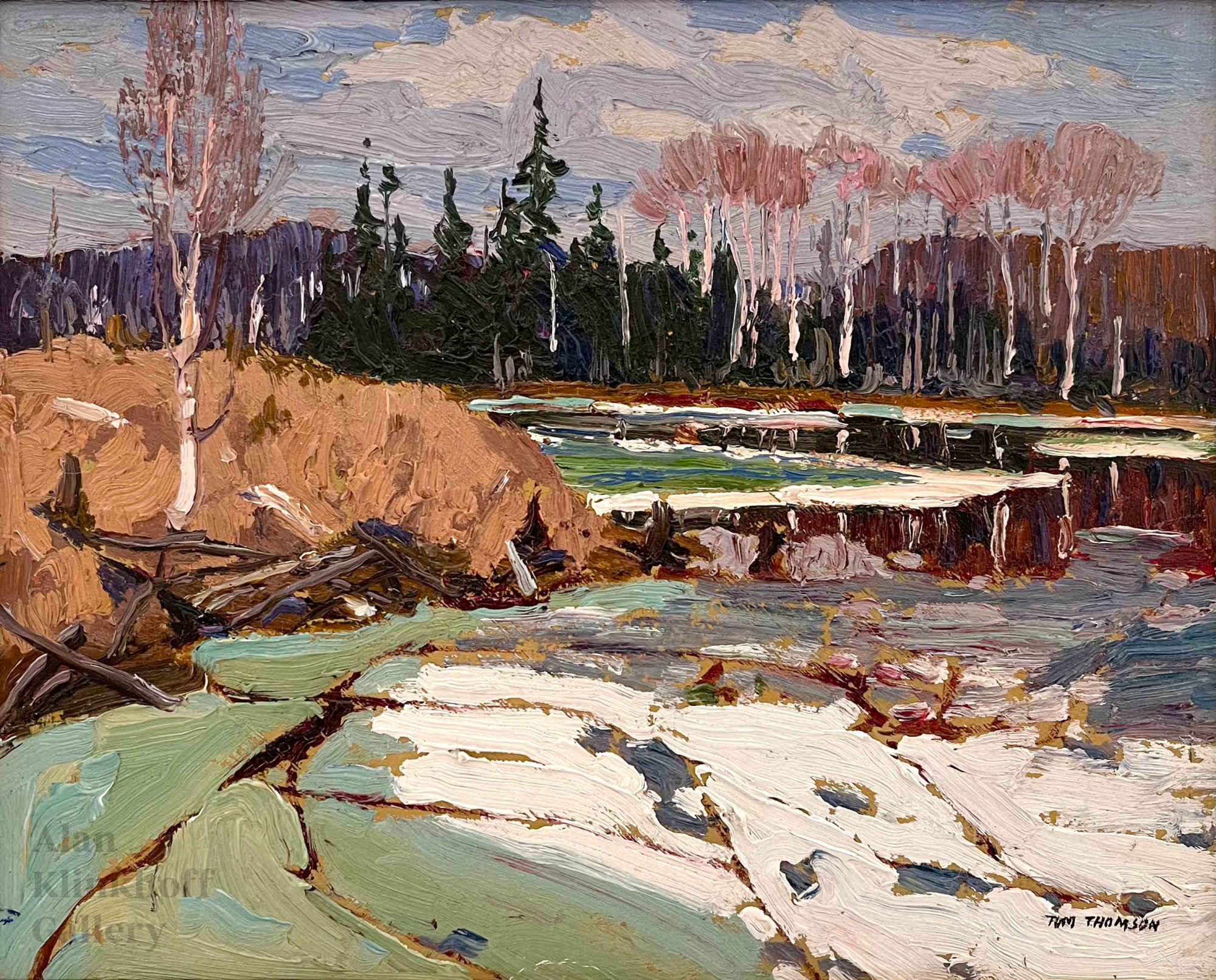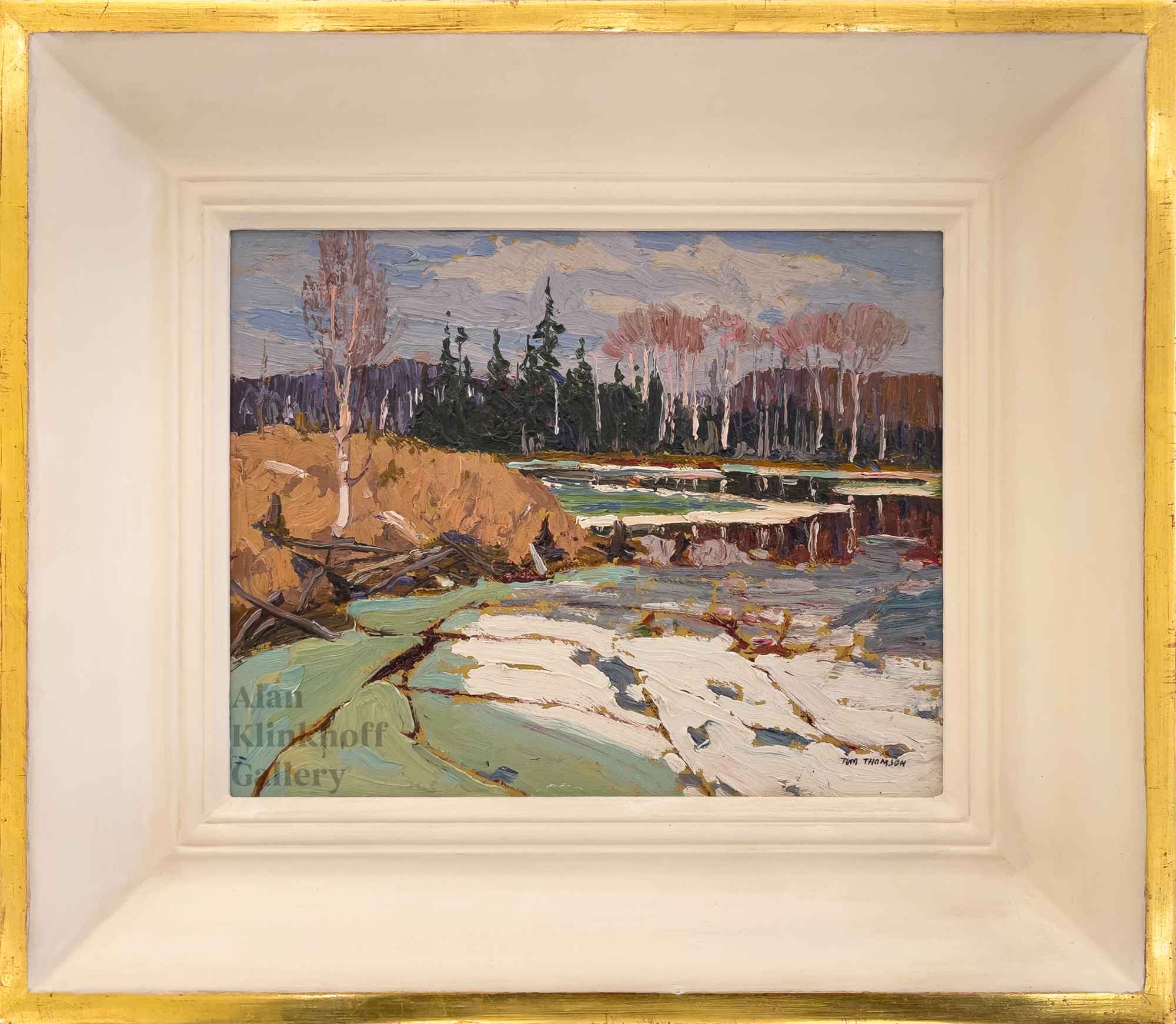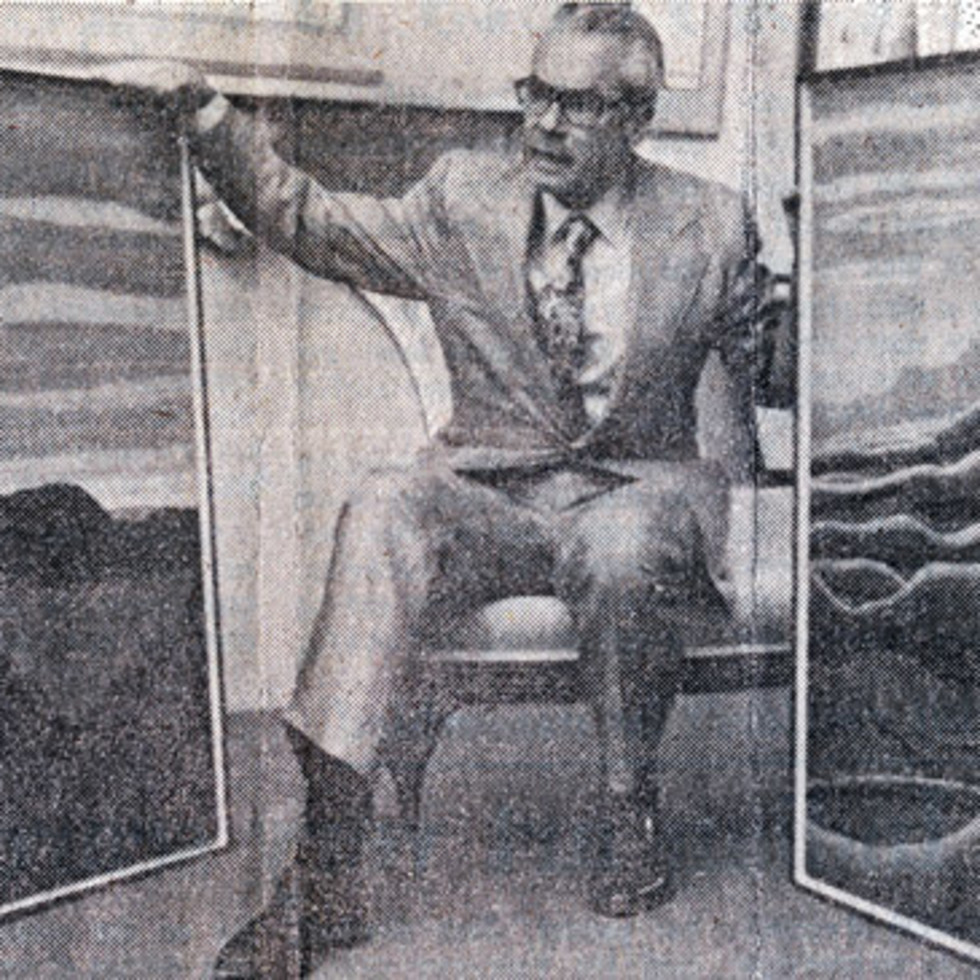Notable Sales
River in Spring (Spring Break-up or Spring Ice), 1916 (Spring)
21.6 x 26.7 cm
Inscriptions
signed by the artist, 'TOM THOMSON' (lower right); inscribed, ‘CAT.90’ (verso frame, upper left, in crayon); titled & inscribed, ‘Spring Ice / TOM THOMSON / Mrs. J.S. McLean’ (verso frame, upper right, in graphite)Provenance
The J.S. McLean Collection of Canadian Painting
Edith Lillian Flavelle McLean, probably circa 1954, bequest from the above, her late husband
William F. McLean, probably circa 1967, by descent from the above, his mother
Carol June McLean, circa 2001, bequest from the above, her husband
Private collection, Ontario.
Exhibitions
Ottawa, National Gallery of Canada, 1952, Paintings and Drawings from the Collection of J.S. McLean, no. 90 as River in SpringLiterature
J.S. McLean, On the Pleasure of Collecting Paintings, Canadian Art, X:1 (Autumn 1952) p.4From 1912 to 1917 Thomson sketched on a variety of supports. He began using composite wood-pulp boards, principally produced for book binding, in 1914 and continued to use them on occasion into 1916 when he painted more frequently on wood panels of similar dimensions, approximately 8 ½ x 10 ½ inches.
Thomson infrequently signed his oil sketches, seeing them as studies rather than finished paintings. Yet it is in his oil sketches that one finds his true contributions to Canadian art. Working up the sketch into the larger dimensions of a canvas posed different challenges and more formal design decisions. In the smaller dimensions of the oil sketch Thomson was able to capture all the immediacy and vivacity of his intense perception. Painted with apparent rapidity, he boldly experimented with fluid brushwork and daring colour contrasts.
River in Spring is a remarkable study of the textures and colours of the spring breakup in the north. Ice still lingers at the water’s edge but has disappeared from the mound at the left. Each brushstroke stands out and is applied with equal solidity and intensity in sky, trees, earth and ice. With a remarkable range of tones, he painted the ice in varying greens highlighted with pale blues and soft greys, whites, pinks, reds and purples separated and linked by the yellow ochre priming. The solid earth mound centre left, painted in a variety of browns, is bordered by driftwood of greys, mauves and blues. A young birch, the sole survivor amidst the beaver cut stumps, stands proudly at the left, echoing the birches on the far shore. The centre band of the far shore flows from purple hills to black spruce to the delicate, pinkish buds of the birches against the maroon hill reflected in the open water centre right. Rapidly moving clouds crown the composition.
The artist Harold Town has most perceptively described Thomson’s technique. “Thomson could manipulate a brush with easy virtuosity, hesitating in the middle of a stroke, turning abruptly during sweep, flattening and extending the width, contracting, rolling the hair to its edge without … losing his rhythm. The brush caught just enough of the wet underpainting to adhere and mark the pigment without muddying the individual hues. When necessary, he pressed down and produced a neutralized squash of colour that saved him from interrupting a stabbing arm movement by mixing on the palette those indeterminate shades of oil that referee the struggle between brilliant colours.” The whole was conceived in his head before he applied his brush.
Unusually, Thomson signed this sketch, suggesting he may have given it to a friend. It was subsequently acquired by the noted collector and philanthropist, J.S. McLean, president of Canada Packers and a major supporter of Canadian art and the Art Gallery of Toronto (now Art Gallery of Ontario). When McLean’s collection was shown at the National Gallery of Canada in February and March 1952, it included eight oil sketches by Tom Thomson, five of which were signed by the artist. As McLean wrote later that year, he began collecting in the late 1920s beginning with paintings by the Group of Seven. “Tom Thomson had been dead more than ten years and, although I have several of his oil sketches, including that of the “West Wind”, I have never been able to secure a good Thomson canvas.” Five of the Thomsons exhibited in 1952 were subsequently donated to the Art Gallery of Ontario, including the sketch for The West Wind, and Joan Murray has identified two others from the McLean collection that were subsequently sold at auction. However, she had not been able to locate this painting that was Catalogue 90 in the 1952 exhibition, where it was rather unimaginatively titled River in Spring, so it has not yet been added to her immensely important Thomson catalogue raisonné. Recently Murray has written an enthusiastic description of this sketch which up to now was the missing Thomson from the McLean collection.
By Charles C. Hill, C.M., Curator of Canadian Art, National Gallery of Canada (ret)
© Copyright Charles C. Hill and Alan Klinkhoff Gallery
—
Tom Thomson’s Spring Break-up
by Joan Murray
Tom Thomson’s Spring Break-up, depicts the first signs of spring in 1916 in Algonquin Park. Trees and fallen debris frame the scene of swiftly-flowing water and departing ice. Ice is piled against the distant shore. The vigorous birch trees on the distant shore and in the left foreground in front of the dark gold hillside burst upwards (there’s pale pink at the tops of the trees at the right which suggests growth) and the sky overhead with its surging clouds suggests energy. It’s a scene of motion, painted with a bold treatment of paint and abbreviated yet delicate brushwork.
After Thomson’s death, A.Y. Jackson described Thomson’s central position in the Group of Seven as “the guide”. At this time, Thomson actually was a guide. Beginning in late April or early May of 1916, he had taken his friends, Lawren Harris, who brought along his cousin Chester Harris, and Dr. James MacCallum on a camping trip in Algonquin Park, starting at Canoe Lake and canoeing to Lake Cauchon. Here, they had left MacCallum and gone on to Aura Lea Lake, by canoe and portage – a lengthy, arduous trip.
Thomson painted several sketches on the trip which can be picked out of his work such as the newly discovered sketch Spring, 1916 which seems to have the same or a similar material; Aura Lee Lake, titled on the reverse Spring Aura Lee Lake by Thomson himself; Early April; and Early Spring, Cauchon Lake. There are several others that may fit, but compared with some of them, Spring Break-up is filled with motion. Racing, ice-filled water, cracking ice, trees bursting with energy, surging sky – although a literal depiction, these features make the sketch dynamic.
pring Break-up belonged to the collection of J.S. McLean (1876-1954), founder of Canada Packers Ltd in 1927 and an important figure to the Art Gallery of Ontario. In 1969, the J.S. McLean Foundation gave the gallery five works by Thomson and some of them are considered the most important of Thomson’s work – such as the sketch for The West Wind, which had been presented to him in 1946 by Quarter Century Club of Canada Packers.
Unusually for Thomson’s work in the sketch medium, Thomson signed the work. Perhaps he was urged to do so by Lawren Harris who may have taken the sketch with him after his camping trip with Thomson, intending to sell the work (Harris acted as Thomson`s “banker”). Perhaps Harris sold it to McLean who would have been well-known to him as a member of Harris’ milieu. Perhaps Thomson was alive at the time (he died mysteriously in 1917) since Spring Break-up has no studio stamp which his friend J.E.H. MacDonald applied to all the Thomson works that remained in the Studio Building after his death.
But these ideas are supposition. How McLean acquired the work is unknown. Sufficient to say Spring Break-up is a worthy addition to the record of Tom Thomson's work and casts light on what he might have achieved if he had lived as more than a crucial pioneer in Canadian art.
By Joan Murray, author of the Tom Thomson Catalogue Raisonné
© Copyright Joan Murray and Alan Klinkhoff Gallery
















